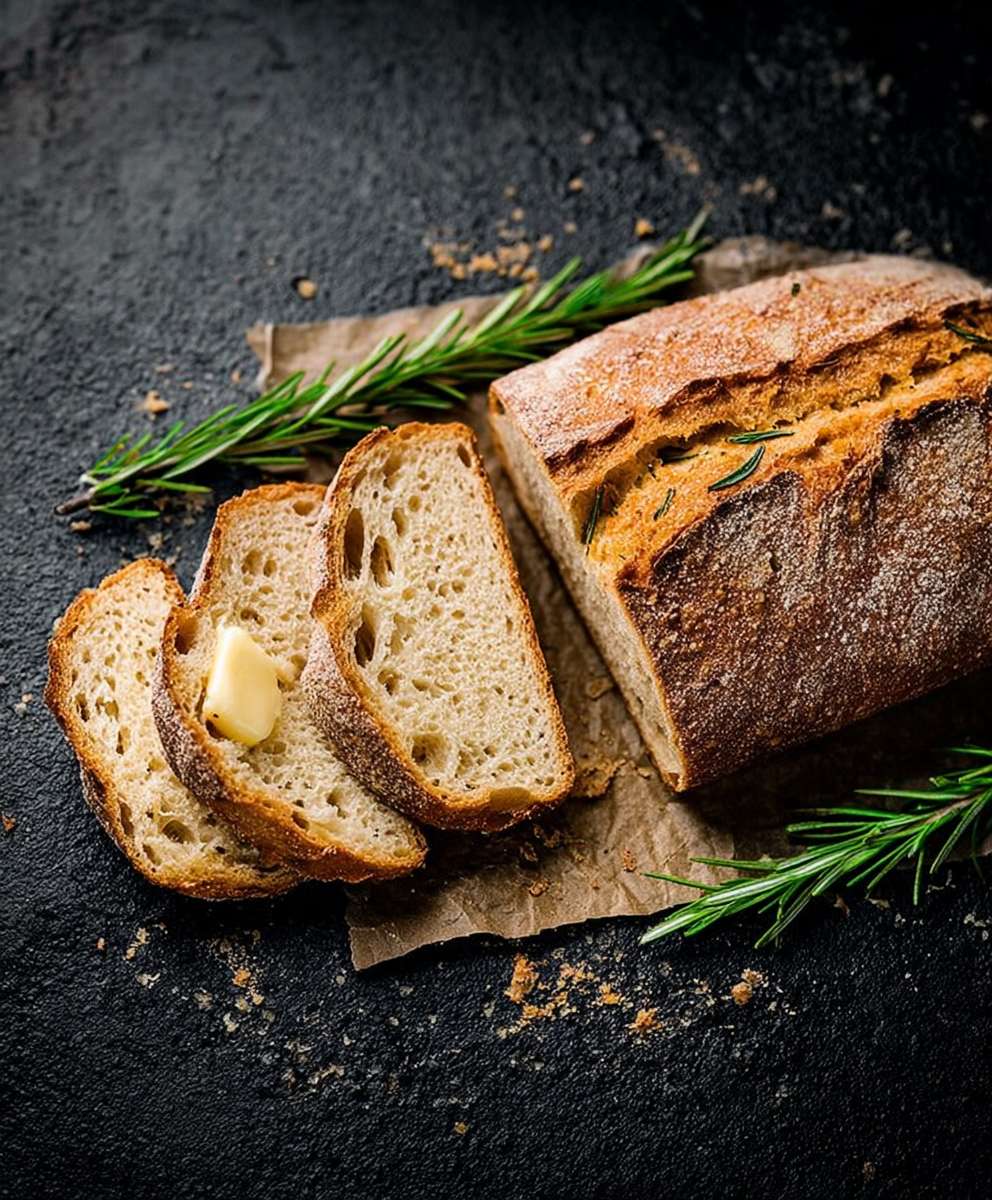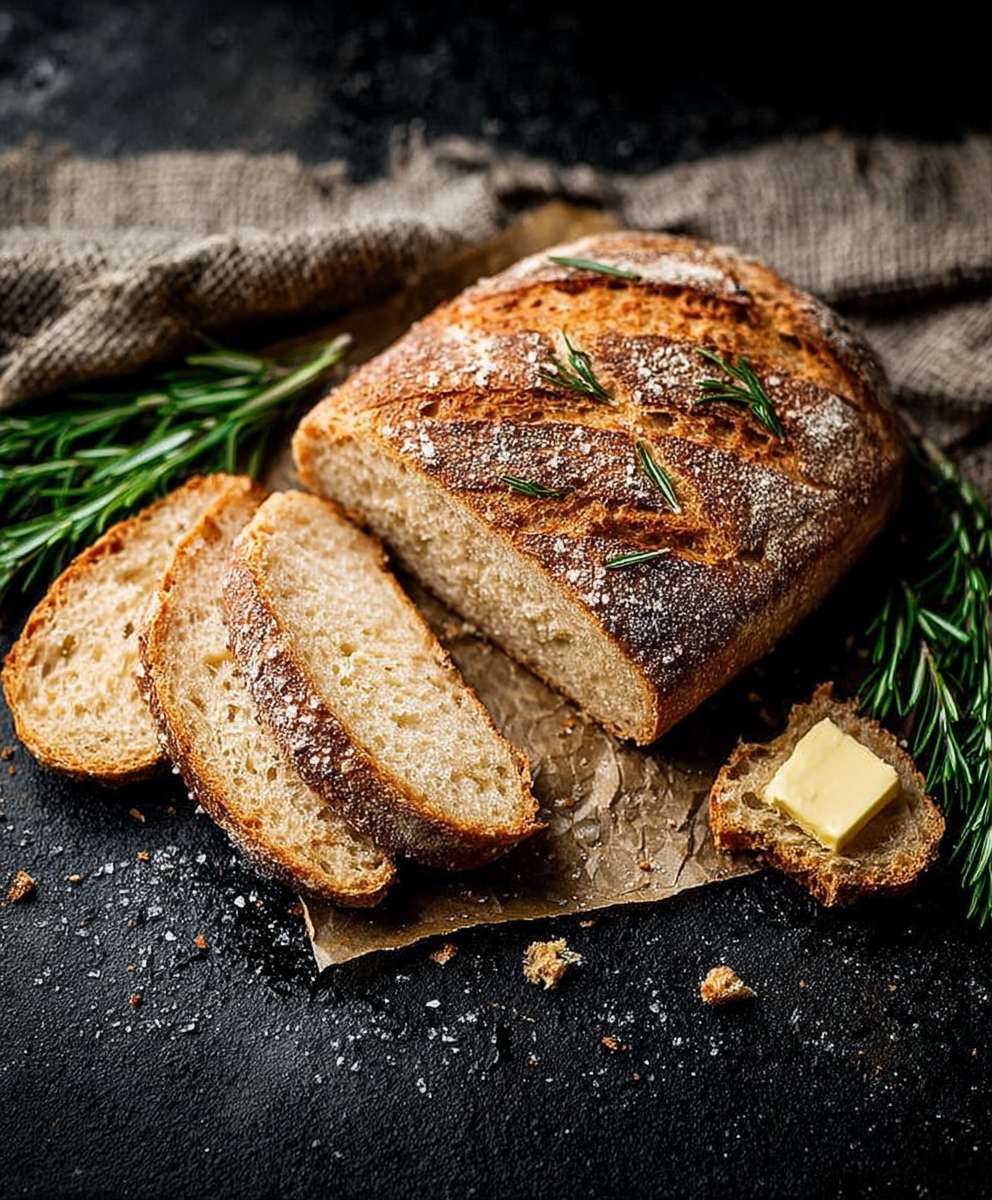Rosemary Parmesan Dutch Oven Bread: the aroma alone is enough to transport you to a rustic Italian countryside kitchen! Imagine pulling a loaf of perfectly crusty, golden-brown bread from your oven, the savory scent of rosemary and nutty parmesan filling the air. This isn’t just bread; it’s an experience, a simple pleasure that elevates any meal.
The beauty of Dutch oven bread lies in its simplicity and the incredible results it yields. The enclosed environment of the Dutch oven creates a steamy haven, allowing the crust to develop a remarkable crispness while the inside remains soft and chewy. While bread baking has ancient roots, the Dutch oven method offers a modern convenience, making artisan-quality bread accessible to home bakers of all skill levels. This particular variation, Rosemary Parmesan Dutch Oven Bread, adds a delightful twist to the classic, infusing it with herbaceous and cheesy notes that are simply irresistible.
People adore this bread for so many reasons. The combination of the crunchy crust and the soft, airy interior is a textural delight. The rosemary and parmesan create a savory flavor profile that complements a wide range of dishes, from hearty soups and stews to simple salads and charcuterie boards. Plus, the ease of preparation makes it a winner – minimal kneading and a hands-off baking process mean you can enjoy freshly baked bread with minimal effort. Get ready to impress your family and friends with this stunning and delicious loaf!
Ingredients:
- For the Dough:
- 3 ½ cups (420g) all-purpose flour, plus more for dusting
- 1 teaspoon instant yeast
- 2 teaspoons kosher salt
- 1 ½ cups (360ml) warm water (around 110°F/43°C)
- 2 tablespoons olive oil, plus more for greasing the bowl
- For the Rosemary Parmesan Crust:
- 2 tablespoons olive oil
- 2 tablespoons finely chopped fresh rosemary
- ½ cup grated Parmesan cheese, finely grated
- ¼ teaspoon garlic powder
- Pinch of red pepper flakes (optional)
- Coarse sea salt, for sprinkling
Preparing the Dough:
- In a large bowl, whisk together the flour, instant yeast, and kosher salt. Make sure the yeast is evenly distributed throughout the flour mixture. This ensures proper activation and a consistent rise.
- Add the warm water and 2 tablespoons of olive oil to the dry ingredients. Use a wooden spoon or your hands to mix until a shaggy dough forms. The dough will be quite sticky, and that’s perfectly fine. Don’t be tempted to add more flour at this stage.
- Turn the dough out onto a lightly floured surface. Knead the dough for about 5-7 minutes, or until it becomes smoother and more elastic. If the dough is still too sticky to handle, add a little bit of flour, one tablespoon at a time, until it becomes manageable. Avoid adding too much flour, as this can result in a dense bread.
- Lightly grease a large bowl with olive oil. Place the dough in the bowl, turning to coat all sides with the oil. This will prevent the dough from sticking to the bowl as it rises.
- Cover the bowl with plastic wrap or a clean kitchen towel. Let the dough rise in a warm place for at least 1 ½ to 2 hours, or until it has doubled in size. The rising time will depend on the temperature of your environment. A warmer environment will result in a faster rise.
Preparing the Rosemary Parmesan Crust:
- While the dough is rising, prepare the rosemary Parmesan crust. In a small bowl, combine the 2 tablespoons of olive oil, finely chopped fresh rosemary, grated Parmesan cheese, garlic powder, and red pepper flakes (if using). Mix well to combine. The mixture should form a thick paste.
- Set the rosemary Parmesan mixture aside until the dough is ready.
Shaping and Proofing the Dough:
- Once the dough has doubled in size, gently punch it down to release the air. Turn the dough out onto a lightly floured surface.
- Gently shape the dough into a round loaf. Be careful not to overwork the dough, as this can deflate it.
- Place the shaped loaf on a piece of parchment paper. This will make it easier to transfer the bread to the Dutch oven later.
- Using a sharp knife or a lame, score the top of the loaf with a cross or a few slashes. This will allow the bread to expand properly during baking and prevent it from cracking unevenly.
- Brush the top of the loaf generously with the rosemary Parmesan mixture. Make sure to cover the entire surface of the loaf.
- Sprinkle the top of the loaf with coarse sea salt.
- Cover the loaf loosely with plastic wrap or a clean kitchen towel. Let it proof for another 30-45 minutes. This second rise will help the bread become even lighter and airier.
Baking the Bread:
- Preheat your oven to 450°F (232°C) with your Dutch oven inside. It’s crucial to preheat the Dutch oven for at least 30 minutes to ensure a crispy crust. Be extremely careful when handling the hot Dutch oven.
- Carefully remove the hot Dutch oven from the oven. Using the parchment paper as a sling, gently lower the loaf into the Dutch oven.
- Cover the Dutch oven with the lid and bake for 30 minutes. Baking with the lid on creates a steamy environment that helps the bread rise and develop a beautiful crust.
- After 30 minutes, remove the lid and continue baking for another 15-20 minutes, or until the crust is golden brown and the internal temperature of the bread reaches 200-210°F (93-99°C). Keep a close eye on the bread during this stage to prevent it from burning.
- Carefully remove the bread from the Dutch oven and transfer it to a wire rack to cool completely before slicing and serving. This is important because slicing the bread while it’s still hot can result in a gummy texture.
Tips and Variations:
- Flour Type: While all-purpose flour works well, you can also use bread flour for a chewier texture.
- Rosemary: If you don’t have fresh rosemary, you can use dried rosemary, but use about half the amount.
- Cheese: You can substitute Parmesan cheese with other hard cheeses like Asiago or Pecorino Romano.
- Garlic: For a stronger garlic flavor, you can add a clove of minced garlic to the rosemary Parmesan mixture.
- Spicy Kick: Add a pinch of red pepper flakes to the dough for a subtle spicy kick.
- Herbs: Experiment with other herbs like thyme, oregano, or sage in the rosemary Parmesan crust.
- Dutch Oven Size: A 5-6 quart Dutch oven is ideal for this recipe.
- No Dutch Oven? If you don’t have a Dutch oven, you can bake the bread on a baking sheet lined with parchment paper. However, the crust won’t be as crispy. You can create a steamy environment by placing a pan of hot water on the bottom rack of the oven during baking.
- Overnight Rise: For a more complex flavor, you can let the dough rise in the refrigerator overnight. This slow fermentation process will enhance the taste of the bread.
- Scoring Patterns: Get creative with your scoring patterns! Experiment with different designs to make your bread visually appealing.
- Serving Suggestions: This Rosemary Parmesan Dutch Oven Bread is delicious on its own, but it’s also great served with soups, salads, or as a side dish to your favorite meal. It’s also perfect for making sandwiches or toast.
- Storage: Store leftover bread in an airtight container at room temperature for up to 3 days. For longer storage, you can freeze the bread. Wrap it tightly in plastic wrap and then in aluminum foil. Thaw the bread completely before serving. You can also reheat the bread in the oven to restore its crispy crust.
Troubleshooting:
- Dough Not Rising: Make sure your yeast is fresh and that the water is warm, but not too hot. If the water is too hot, it can kill the yeast. Also, make sure the environment is warm enough for the dough to rise properly.
- Bread Too Dense: Avoid adding too much flour to the dough. Over-kneading can also result in a dense bread.
- Crust Too Dark: If the crust is getting too dark before the bread is fully cooked, you can tent it with aluminum foil.
- Bread Sticking to Dutch Oven: Make sure to grease the Dutch oven well or use parchment paper to prevent the bread from sticking.
Enjoy your homemade Rosemary Parmesan Dutch Oven Bread! I hope you find this recipe easy to follow and that the bread turns out perfectly every time. Happy baking!

Conclusion:
This Rosemary Parmesan Dutch Oven Bread isn’t just another bread recipe; it’s an experience. The crusty exterior gives way to a soft, airy interior infused with the fragrant rosemary and savory parmesan, creating a symphony of flavors and textures that will elevate any meal. It’s the kind of bread that makes you want to tear off a piece and savor every single bite. Trust me, the aroma alone baking in your kitchen is worth the effort!
But why is this a must-try? Because it’s surprisingly simple to make, even for novice bakers. The Dutch oven does most of the work, creating the perfect environment for a beautifully risen loaf with that coveted crispy crust. Plus, the combination of rosemary and parmesan is simply irresistible. It’s a crowd-pleaser, a conversation starter, and a guaranteed way to impress your friends and family.
Serving Suggestions and Variations:
This Rosemary Parmesan Dutch Oven Bread is incredibly versatile. Serve it warm with a drizzle of olive oil and a sprinkle of sea salt for a simple yet elegant appetizer. It’s also fantastic alongside soups, stews, and salads, adding a touch of rustic charm to your meal. Imagine dipping a slice into a hearty bowl of tomato soup on a chilly evening – pure comfort food!
For a truly decadent experience, try using it to make grilled cheese sandwiches. The crispy crust and flavorful interior will take your grilled cheese game to a whole new level. You can also cube it and use it for croutons, adding a burst of flavor to your salads.
Feeling adventurous? Here are a few variations you might enjoy:
* Garlic Rosemary Parmesan: Add a few cloves of minced garlic to the dough for an extra layer of flavor.
* Sun-Dried Tomato and Parmesan: Incorporate chopped sun-dried tomatoes for a tangy and savory twist.
* Everything Bagel Seasoning: Sprinkle everything bagel seasoning on top of the loaf before baking for a delightful crunch and flavor.
* Different Cheeses: Experiment with different cheeses like Asiago, Pecorino Romano, or even a sharp cheddar for a unique flavor profile.
* Herb Combinations: While rosemary is the star, feel free to add other herbs like thyme, oregano, or sage to create your own signature blend.
I truly believe that this Rosemary Parmesan Dutch Oven Bread will become a staple in your kitchen. It’s a recipe that’s both satisfying to make and incredibly rewarding to eat. The process of nurturing the dough, watching it rise, and then finally pulling a golden-brown loaf from the oven is an experience in itself.
So, what are you waiting for? Gather your ingredients, preheat your oven, and get ready to bake! I’m confident that you’ll love this recipe as much as I do.
And please, don’t be shy! Once you’ve tried it, I’d love to hear about your experience. Share your photos, your variations, and your tips in the comments below. Let’s create a community of bread-baking enthusiasts and inspire each other to create delicious and memorable meals. Happy baking!
Rosemary Parmesan Dutch Oven Bread: The Ultimate Guide
A flavorful and crusty Rosemary Parmesan Dutch Oven Bread, perfect for serving with soups, salads, or as a delicious side.
Ingredients
Instructions
Recipe Notes
- Flour Type: All-purpose flour works well, but bread flour can be used for a chewier texture.
- Rosemary: If you don’t have fresh rosemary, you can use dried rosemary, but use about half the amount.
- Cheese: You can substitute Parmesan cheese with other hard cheeses like Asiago or Pecorino Romano.
- Garlic: For a stronger garlic flavor, you can add a clove of minced garlic to the rosemary Parmesan mixture.
- Spicy Kick: Add a pinch of red pepper flakes to the dough for a subtle spicy kick.
- Herbs: Experiment with other herbs like thyme, oregano, or sage in the rosemary Parmesan crust.
- Dutch Oven Size: A 5-6 quart Dutch oven is ideal for this recipe.
- No Dutch Oven? If you don’t have a Dutch oven, you can bake the bread on a baking sheet lined with parchment paper. However, the crust won’t be as crispy. You can create a steamy environment by placing a pan of hot water on the bottom rack of the oven during baking.
- Overnight Rise: For a more complex flavor, you can let the dough rise in the refrigerator overnight. This slow fermentation process will enhance the taste of the bread.
- Scoring Patterns: Get creative with your scoring patterns! Experiment with different designs to make your bread visually appealing.
- Serving Suggestions: This Rosemary Parmesan Dutch Oven Bread is delicious on its own, but it’s also great served with soups, salads, or as a side dish to your favorite meal. It’s also perfect for making sandwiches or toast.
- Storage: Store leftover bread in an airtight container at room temperature for up to 3 days. For longer storage, you can freeze the bread. Wrap it tightly in plastic wrap and then in aluminum foil. Thaw the bread completely before serving. You can also reheat the bread in the oven to restore its crispy crust.





Leave a Comment